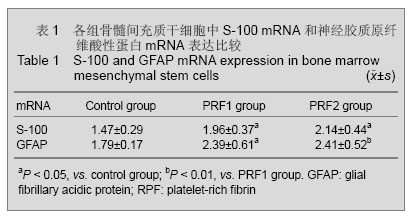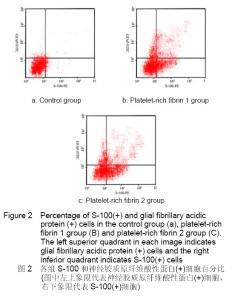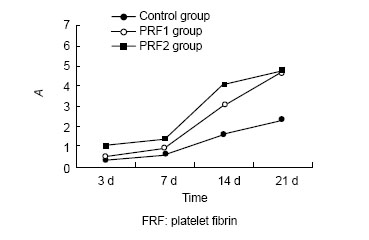Chinese Journal of Tissue Engineering Research ›› 2012, Vol. 16 ›› Issue (49): 9157-9161.doi: 10.3969/j.issn.2095-4344.2012.49.007
Previous Articles Next Articles
Platelet-rich fibrin induces the differentiation of bone marrow mesenchymal stem cells into Schwann cells
Feng Yu-hua1, Dong Jing1, Lu Lei2, Li Qi3, Song Lei4
- 1Affiliated Hosital of Jilin Medical College, Jinlin 132013, Jilin Province, China; 2Department of Neurology, Harrison International Peace Hospital, Hengshui 053000, Hebei Province, China; 3Implantation Centre, Stomatology Hospital, Jilin University, Changchun 130021, Jilin Province, China; 4Department of Neurology, First Hospital of Norman Bethune College of Medicine of Jilin University, Changchun 130021, Jilin Province, China
-
Received:2012-04-10Revised:2012-06-21Online:2012-12-02Published:2013-01-16 -
About author:Feng Yu-hua, Attending physician, Affiliated Hosital of Jilin Medical College, Jinlin 132013, Jilin Province, China articlehelp@163.com
CLC Number:
Cite this article
Feng Yu-hua, Dong Jing, Lu Lei, Li Qi, Song Lei. Platelet-rich fibrin induces the differentiation of bone marrow mesenchymal stem cells into Schwann cells[J]. Chinese Journal of Tissue Engineering Research, 2012, 16(49): 9157-9161.
share this article

2.3 富血小板纤维蛋白诱导骨髓间充质干细胞中S-100 mRNA和神经胶质原纤维酸性蛋白mRNA表达 于培养21 d取3组细胞进行QRT-PCR测定,以与β-actin的比值表示结果:与对照组相比,富血小板纤维蛋白1组骨髓间充质干细胞中S-100及神经胶质原纤维酸性蛋白mRNA表达增高(P < 0.05);与对照组相比,富血小板纤维蛋白2组骨髓间充质干细胞中S-100 mRNA表达增高(P < 0.05),神经胶质原纤维酸性蛋白mRNA表达显著性升高(P < 0.01);与富血小板纤维蛋白1组相比,富血小板纤维蛋白2组S-100与神经胶质原纤维酸性蛋白mRNA表达无明显差异(P > 0.05),见表1。"


2.4 富血小板纤维蛋白促进骨髓间充质干细胞分化 培养21 d后,荧光抗体S-100、神经胶质原纤维酸性蛋白直接标记3组骨髓间充质干细胞,流式细胞学检测3组S-100(+)和GFAP(+)细胞百分比,结果显示:对照组S-100(+)细胞数占总细胞数(3.38±0.68)%,神经胶质原纤维酸性蛋白(+)细胞百分比为(4.96±0.41)%;与对照组相比,富血小板纤维蛋白1组S-100(+)、神经胶质原纤维酸性蛋白(+)细胞数增多(P < 0.05),分别为(38.78± 10.42)%和(22.74±10.28)%;富血小板纤维蛋白2组S-100(+)及神经胶质原纤维酸性蛋白(+)细胞数分别为(40.04±10.10)%和(24. 32±12. 23)%,与富血小板纤维蛋白1组相比差异无显著性意义(P > 0.05),见图2。"

| [1] Choukroun J, Adda F, Schoeffler C, et al. Une opportunite’ en paro-implantologie: le PRF. Implantodontie. 2000; 42: 55-62. [2] Dohan DM, Choukroun J, Diss A,et al. Platelet-rich fibrin (PRF): a second-generation platelet concentrate. Part II: platelet-related biologic features. Oral Surg Oral Med Oral Pathol Oral Radiol Endod. 2006;101(3):e45-50. [3] Lundquist R, Dziegiel MH, Agren MS. Bioactivity and stability of endogenous fibrogenic factors in platelet-rich fibrin. Wound Repair Regen. 2008;16(3):356-363. [4] Farrag TY, Lehar M, Verhaegen P,et al. Effect of platelet rich plasma and fibrin sealant on facial nerve regeneration in a rat model. Laryngoscope. 2007;117(1):157-165. [5] The Ministry of Science and Technology of the People’s Republic of China. Guidance Suggestions for the Care and Use of Laboratory Animals. 2006-09-30. 中华人民共和国科学技术部. 关于善待实验动物的指导性意见.2006-09-30. [6] Guo XM, Wang CY, Wang YH,et al. Experimental study of the isolation, culture and in chondrogenic differentiation of human bone mesenchymal stem cell.Zhonghua Kou Qiang Yi Xue Za Zhi. 2003;38(1):63-66. [7] Romero-Ramirez L, Cao H, Regalado MP,et al. X box-binding protein 1 regulates angiogenesis in human pancreatic adenocarcinomas.Transl Oncol. 2009;2(1):31-38. [8] Dohan DM, Choukroun J, Diss A,et al. Platelet-rich fibrin (PRF): a second-generation platelet concentrate. Part I: technological concepts and evolution. Oral Surg Oral Med Oral Pathol Oral Radiol Endod. 2006;101(3):e37-44. [9] Kikuchi M, Yatabe M, Tando Y,et al. Immunohistochemical localization of anterior pituitary hormones in S-100 protein-positive cells in the rat pituitary gland. Cell Tissue Res. 2011;345(3):425-429. [10] Eng LF, Ghirnikar RS, Lee YL. Glial fibrillary acidic protein: GFAP-thirty-one years (1969-2000). Neurochem Res. 2000; 25(9-10):1439-1451. [11] Mantur M, Koper O. Platelet- derived growth factor--the construction, role and it's receptors. Pol Merkur Lekarski. 2008;24(140):173-176. [12] Movaghar B, Tiraihi T, Mesbah-Namin SA.Transdifferentiation of bone marrow stromal cells into Schwann cell phenotype using progesterone as inducer. Brain Res. 2008;1208:17-24. |
| [1] | Lyu Ruyue, Gu Lulu, Liu Qian, Zhou Siyi, Li Beibei, Xue Letian, Sun Peng. Regulatory mechanisms of exosome secretion and its application prospects in biomedicine [J]. Chinese Journal of Tissue Engineering Research, 2026, 30(1): 184-193. |
| [2] | Xu Canli, He Wenxing, Wang Yuping, Ba Yinying, Chi Li, Wang Wenjuan, Wang Jiajia. Research context and trend of TBK1 in autoimmunity, signaling pathways, gene expression, tumor prevention and treatment [J]. Chinese Journal of Tissue Engineering Research, 2026, 30(在线): 1-11. |
| [3] | Liu Xun, Ouyang Hougan, Pan Rongbin, Wang Zi, Yang Fen, Tian Jiaxuan . Optimal parameters for physical interventions in bone marrow mesenchymal stem cell differentiation [J]. Chinese Journal of Tissue Engineering Research, 2025, 29(31): 6727-6732. |
| [4] | Lin Meiyu, Zhao Xilong, Gao Jing, Zhao Jing, Ruan Guangping. Action mechanism and progress of stem cells against ovarian granulosa cell senescence [J]. Chinese Journal of Tissue Engineering Research, 2025, 29(25): 5414-5421. |
| [5] | Hu Enxi, He Wenying, Tao Xiang, Du Peijing, Wang Libin. Regulation of THZ1, an inhibitor of cyclin-dependent kinase 7, on stemness of glioma stem cells and its mechanism [J]. Chinese Journal of Tissue Engineering Research, 2025, 29(25): 5374-5381. |
| [6] | Tian Zhenli, Zhang Xiaoxu, Fang Xingyan, Xie Tingting. Effects of sodium arsenite on lipid metabolism in human hepatocytes and regulatory factors [J]. Chinese Journal of Tissue Engineering Research, 2025, 29(23): 4956-4964. |
| [7] | Han Fang, Shu Qing, Jia Shaohui, Tian Jun. Electrotactic migration and mechanisms of stem cells [J]. Chinese Journal of Tissue Engineering Research, 2025, 29(23): 4984-4992. |
| [8] | Hu Chen, Jiang Ying, Chen Jia, Qiao Guangwei, Dong Wen, Ma Jian. Preparation and characterization of alendronate/chitosan/polyvinyl alcohol composite hydrogel films [J]. Chinese Journal of Tissue Engineering Research, 2025, 29(22): 4720-4730. |
| [9] | Yang Chao, Luo Zongping. Small molecule drug TD-198946 enhances osteogenic differentiation of rat bone marrow mesenchymal stem cells [J]. Chinese Journal of Tissue Engineering Research, 2025, 29(13): 2648-2654. |
| [10] | Li Xiaofeng, Zhao Duo, Ouyang Qin, Pang Zixiang, Li Yuquan, Chen Qianfen. Protective effect of mangiferin on oxidative stress injury in rat bone marrow mesenchymal stem cells [J]. Chinese Journal of Tissue Engineering Research, 2025, 29(13): 2669-2674. |
| [11] | Hu Zezun, Yang Fanlei, Xu Hao, Luo Zongping. Effect of surface roughness of polydimethylsiloxane on osteogenic differentiation of bone marrow mesenchymal stem cells under stretching conditions [J]. Chinese Journal of Tissue Engineering Research, 2025, 29(10): 1981-1989. |
| [12] | Huang Ting, Zheng Xiaohan, Zhong Yuanji, Wei Yanzhao, Wei Xufang, Cao Xudong, Feng Xiaoli, Zhao Zhenqiang. Effects of macrophage migration inhibitory factor on survival, proliferation, and differentiation of human embryonic stem cells [J]. Chinese Journal of Tissue Engineering Research, 2025, 29(7): 1380-1387. |
| [13] | Yang Zhihang, Sun Zuyan, Huang Wenliang, Wan Yu, Chen Shida, Deng Jiang. Nerve growth factor promotes chondrogenic differentiation and inhibits hypertrophic differentiation of rabbit bone marrow mesenchymal stem cells [J]. Chinese Journal of Tissue Engineering Research, 2025, 29(7): 1336-1342. |
| [14] | Liu Haowen, Qiao Weiping, Meng Zhicheng, Li Kaijie, Han Xuan, Shi Pengbo. Regulation of osteogenic effects by bone morphogenetic protein/Wnt signaling pathway: revealing molecular mechanisms of bone formation and remodeling [J]. Chinese Journal of Tissue Engineering Research, 2025, 29(3): 563-571. |
| [15] | Wang Zhikun, Bai Shaoxuan, Zhao Wei, Wang Chenyu. Exercise preconditioning combined with bone marrow mesenchymal stem cell transplantation for myocardial infarction in rats [J]. Chinese Journal of Tissue Engineering Research, 2025, 29(1): 65-73. |
| Viewed | ||||||
|
Full text |
|
|||||
|
Abstract |
|
|||||

